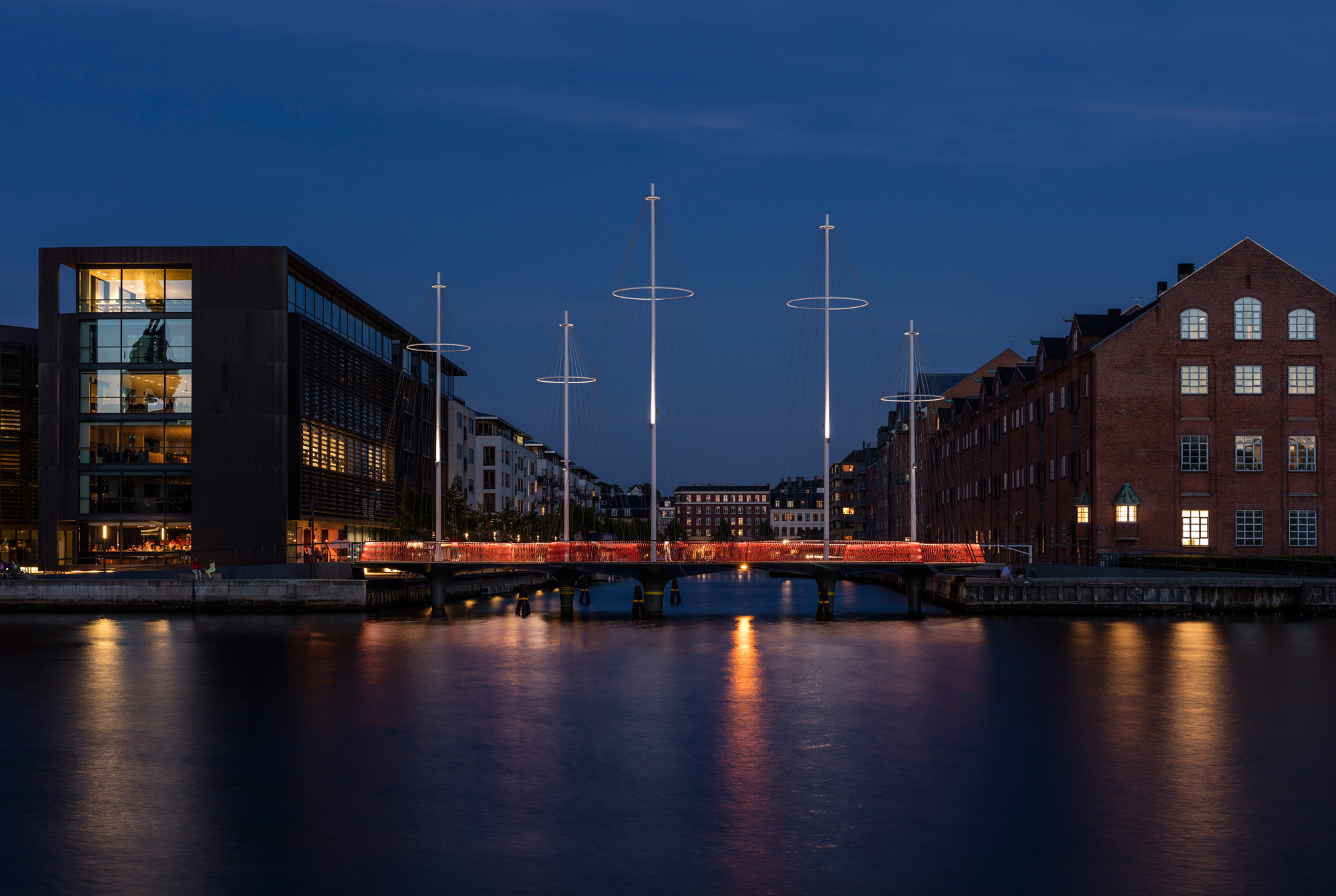Cirkelbroen (The circle bridge) has officially opened in Copenhagen.
More than 7,000 attended the festive opening ceremony for the bridge, where world-renowned Danish-Icelandic artist Olafur Eliasson, the creator of the bridge, spoke alongside Lord Mayor of Copenhagen, Frank Jensen, and Mogens Hugo, the chairman of Nordea-fonden.
Eliasson looks forward to Cirkelbroen becoming part of everyday life for the people of Copenhagen:
“Cirkelbroen creates new spaces along the waterfront. It brings people closer to the water and encourages them to slow down a little and take a break. I hope it will become a meeting place, a ‘see-you-at-the-bridge’ kind of place. “In my art practice, I often use transient materials such as wind, fog and flowing water. It has been wonderful to have the opportunity to make a structure like Cirkelbroen, which both embodies this transience – the changing of the weather and the waterfront atmosphere – and, as a bridge, has a long, stable life ahead of it. I am filled with immense pride to know that Cirkelbroen will now be part of Copenhagen.”
Cirkelbroen will make it easier for the people of Copenhagen to cycle, walk or run along the Copenhagen waterfront and through the city. But it will provide much more than that. It will serve as a new meeting place and vantage point along the waterfront for reflection, new views and perspectives. It invites one to take a break from an otherwise busy day. Frank Jensen, the Lord Mayor of Copenhagen, who received the bridge on behalf of the city, is very pleased with the opening ceremony for Cirkelbroen: “The Cirkelbroen bridge enhances an already lively, and attractive waterfront atmosphere for the people of Copenhagen. This was emphasised today by the presence of such a large number of people at the official opening. The bridge binds our city more tightly together and is a landmark for the entire area of which we can be proud”. Mogens Hugo, chairman of the board for Nordea-fonden, is also very pleased that Copenhagen residents have so warmly welcomed the Cirkelbroen bridge: “We are very pleased by the many people who chose to spend their Saturday with us. Naturally, the most important thing is how the people of Copenhagen will use the bridge in their daily lives. But their positive reception of Cirkelbroen today indicates that the bridge has a bright future ahead”. Cirkelbroen was designed by artist Olafur Eliasson and is a gift from Nordeafonden to the City of Copenhagen. Nordea-fonden is a non-profit and charitable foundation supporting activities that promote good living in Denmark.
Cirkelbroen celebrates pedestrians. It reflects the daily life and intimacy that you find around the canal in the Christianshavn neighbourhood, its houseboats and sailing boats, the unique life on the ramparts. Copenhagen’s harbour was once a centre of maritime activity, and Cirkelbroen is a testimony to that history. While working on the bridge, I remembered the fishing boats I saw as a child in Iceland. In the harbour, the boats were often moored right next to each other, and it sometimes seemed that you could even cross the harbour just by walking from boat to boat.
The bridge is made of five circular platforms, and it contributes to a larger circle that will form a pedestrian route around Copenhagen Harbour, where people – cycling, running, walking – can see the city from a very different perspective. As many as 5,000 people will cross this bridge each day. I hope that these people will use Cirkelbroen as a meeting place, and that the zigzag design of the bridge will make them reduce their speed and take a break. To hesitate on our way is to engage in bodily thought. I see such introspection as an essential part of a vibrant city. In Copenhagen, progress has been made in thinking about what constitutes quality in urban space and about the atmosphere of a space. Obviously, one cannot plan atmosphere, as it is co-produced by the people who use the space, but it is possible to nurture an atmosphere, to allow it to grow. As an artist, I work with abstract and emotional qualities, so this is where, I believe, art can play a role. I’m convinced that politicians, urban planners, and developers need to expand their toolbox by bringing in what I would call creative reality producers – artists, social scientists, sociologists, anthropologists, historians, dancers, poets, environmental activists, and philosophers – to rethink urban spaces.
In Denmark, there is a strong tradition of focusing on inclusion, on accepting the other – welcoming ideas that we have not yet had, people we have not yet met, and unpredictable encounters. It’s something we all have to work on together, and one way of addressing this is in how we plan public space. Cirkelbroen, I hope, will contribute to improving the quality of life and the
development of a hospitable and inclusive city.














1 Comment